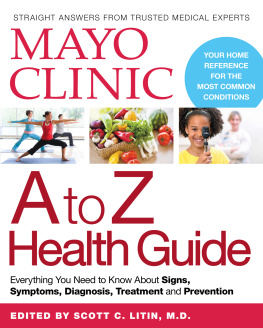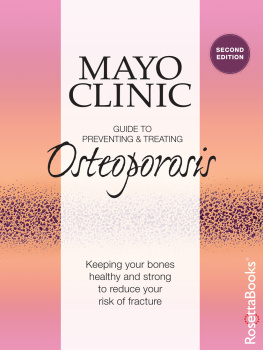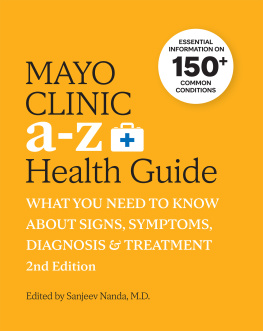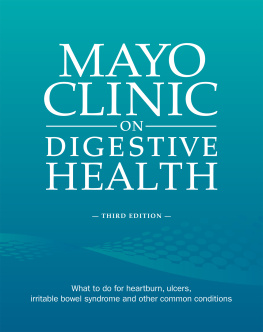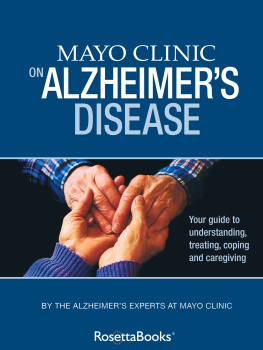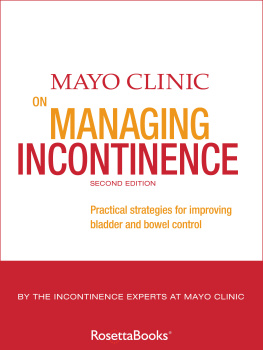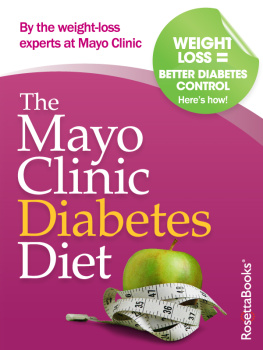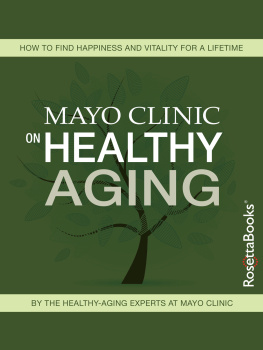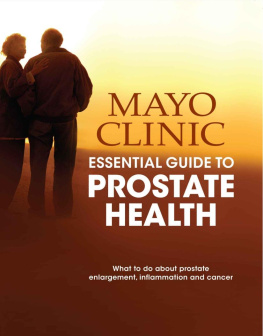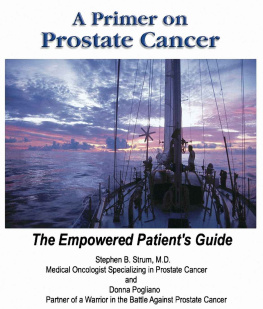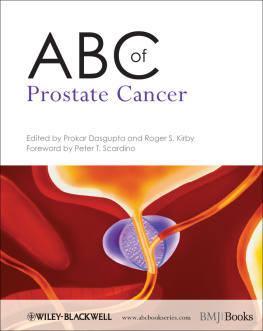
Mayo Clinic Essential Guide to Prostate Health provides reliable information on managing prostate conditions. Much of the information comes from the experience of urologists, radiologists, oncologists and other health care professionals at Mayo Clinic. This book supplements the advice of your physician, whom you should consult for individual medical problems. Mayo Clinic Essential Guide to Prostate Health does not endorse any company or product. MAYO, MAYO CLINIC, MAYO CLINIC HEALTH SOLUTIONS and the Mayo triple-shield logo are marks of Mayo Foundation for Medical Education and Research.
Published by Mayo Clinic Health Solutions
2009 Mayo Foundation for Medical Education and Research
All rights reserved. No part of this book may be reproduced or used in any form or by any means, electronic or mechanical, including photocopying and recording, or by any information storage and retrieval system, without permission in writing from the publisher, except by a reviewer, who may quote brief passages in review.
For bulk sales to employers, member groups and health-related companies, contact Mayo Clinic Health Solutions, 200 First St. SW, Rochester, MN, 55905, or send an e-mail to
Address inquiries to Mayo Clinic Health Solutions, Permissions Department, 200 First St., SW, Fifth floor Centerplace Building, Rochester, MN, 55905.
Stock photography from Artville, BananaStock, Brand X Pictures, Comstock, Corbis, Creatas, Digital Stock, Digital Vision, EyeWire, Food Shapes, Image Ideas, Isabelle Rozenbaum/PhotoAlto, Photodisc, Rubberball and Stockbyte. The individuals pictured are models, and the photos are used for illustrative purposes only. Theres no correlation between the individuals portrayed and the conditions or subjects being discussed. The photos on page 133 are courtesy of Intuitive Surgical Inc.
Library of Congress Control Number: 2008934187
First Edition
1 2 3 4 5 6 7 8 9 10
About Mayo Clinic
Mayo Clinic evolved from the frontier practice of Dr. William Worrall Mayo and the partnership of his two sons, Drs. William J. and Charles H. Mayo, in the early 1900s. Pressed by the demands of their busy practice in Rochester, Minn., the Mayo brothers invited other physicians to join them, pioneering the private group practice of medicine. Today, with more than 2,000 physicians and research scientists at major locations in Rochester, Minn., Jacksonville, Fla., and Phoenix and Scottsdale, Ariz., Mayo Clinic is dedicated to providing comprehensive diagnoses, accurate answers, and effective treatments.
With this depth of medical knowledge, experience and expertise, Mayo Clinic occupies an unparalleled position as a health information resource. Since 1983, Mayo Clinic has published reliable health information for millions of consumers through a variety of award-winning newsletters, books and online services. Revenue from these publishing activities supports Mayo Clinic programs, including medical education and medical research.
Editorial staff
Medical Editor-in-Chief - Lance A. Mynderse, M.D.
Senior Director, Consumer Products and Services - Nicole Spelhaug
Editor-in-Chief, Books and Newsletters - Christopher Frye
Managing Editor - Kevin Kaufman
Contributing Editors and Reviewers - Brent Bauer, M.D., Brian Davis, M.D., Ph.D., James Engh, Igor Frank, M.D., Matthew Gettman, M.D., Peter Gilling, M.D., R. Jeffrey Karnes, M.D., Akira Kawashima, M.D., Ph.D., Bradley Leibovich, M.D., O. Kenneth Macdonald, M.D., Reza Malek, M.D., Robert McLaren, M.D., Mark Nathan, M.D., Ajay Nehra, M.D., J. Fernando Quevedo, M.D.
Creative Director - Daniel Brevick
Art Director - Stewart Koski
Illustrators - Tristan Cummings, Michael King, Kent McDaniel, Christopher Srnka
Research Manager - Deirdre Herman
Research Librarians - Anthony Cook, Amanda Golden
Proofreaders - Miranda Attlesey, Donna Hanson
Indexer - Steve Rath
Administrative Assistant - Beverly Steele
Preface

Lance A. Mynderse, M.D.
Medical Editor-in-Chief
For many adult males, the health concerns associated with prostate disease may be their first contact ever with a physician or, for that matter, with medical care. About 35 percent of men over age 50 will experience an inflammatory condition of the prostate known as prostatitis. Over 50 percent of men over age 60 will feel the discomfort of an enlarged prostate, or benign prostatic hyperplasia (BPH). Finally, prostate cancer is the most frequently diagnosed cancer and the leading cause of cancer death in American men.
Despite these sobering facts, prostate cancer, as well as other forms of prostate disease, is often easily treated, and the outlook for management, cure and survival is excellent. Advances in research, more sophisticated imaging technology and new medical procedures have enabled a much earlier diagnosis of prostate disease and more personalized treatment, reducing recovery time and avoiding many troublesome side effects.
This book will guide you, along with your spouse or significant other, through the decision process you may face as you work with your doctor to treat, manage and possibly cure prostate disease. The key to a good outcome is to educate yourself and to be involved with your doctor at an early stage to address your health concerns.
The more you know about prostate disease, the greater are your chances of identifying problems, making good decisions about treatment options and maintaining a high quality of life. Urologists, as key advocates for mens health, are in a position to educate, guide and assist all men with an individual-centered approach to the management of their health needs.
Table of contents
About the prostate
Getting a prostate checkup
Imaging techniques for the prostate
Prostatitis and chronic pelvic pain
Understanding benign prostatic hyperplasia
Treating benign prostatic hyperplasia
Learning you have cancer
Treatment options for prostate cancer
When cancer is advanced
Coping with complications
Getting on with life
Can you prevent prostate disease?
Complementary and alternative therapies
Part 1

Prostate basics
Chapter 1
About the prostate
T he prostate gland can cause some of the most common health problems that men face, and cancer of the prostate is among the most feared. Thats because prostate cancer, like breast cancer for women, often strikes at the core of human sexuality.
Beyond fear of cancer itself are the possible consequences of treatment issues with bladder control (incontinence) and the inability to have an erection (erectile dysfunction). These problems can be as difficult to deal with as the cancer, eroding self-confidence and evoking feelings of lost masculinity.
But theres reason for optimism. If caught early, prostate cancer often can be successfully treated and cured. Improved medical practice is reducing the risks of incontinence and erectile dysfunction. When these complications occur, treatment may limit their effects.
Next page

